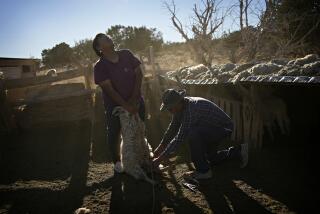Famous for Sheep, New Zealand Tries Grazing New Stock
- Share via
TAUREWA, New Zealand — A sheep dog leaped across a band of ewes bottled up at a paddock ramp leading into a huge stock truck. Barking incessantly, the dog nipped at the newly shorn sheep to force them up the ramp.
“Good dog! Good Babe!” shouted red-headed sheep farmer Brian Oliver, 38, moving 1,000 ewes from his high country ranch near Tongario National Park to another farm.
Sheep are everywhere in this island nation. New Zealand has 20 times as many sheep as people--67 million versus 3.3 million. And in spring, counting lambs, the sheep population swells to 115 million.
In fact, this tiny country is the world’s biggest exporter of mutton. Last year alone, mutton exports (including lamb) were valued at $1.06 billion, or 55% of the world’s supply. It is the third-largest exporter of wool (behind Australia and South Africa), with last year’s exports worth an estimated $868 million.
Superb grass and clover and ideal climate have helped this small nation become a world leader in all kinds of livestock.
“Here in New Zealand, cattle and sheep have always gone together,” explains Norrey Simmons, 38, spokesman for the nation’s Ministry of Agriculture. “Cattle graze on a pasture and eat so far, then sheep are brought in to finish it off. In rugged terrain farmers use goats to keep the rough stuff down so sheep can get at the grass.”
Goats were used almost exclusively for grazing until about 10 years ago when farmers saw the potential of farming Angora goats for mohair and cashmere. Because farm prices have been depressed, interest in goats has skyrocketed since 1982.
New Zealand researchers have invented a new luxury fiber that is a cross between mohair and cashmere called cashgora. There is also a growing market for goat milk, goat cheese and goat meat. Simmons said that within 10 years, New Zealand’s goat production could be as much as a third of its sheep output.
And of late, New Zealand farmers have added another type of livestock to their pastures--deer.
Red deer were introduced from Europe to the rugged backcountry a century ago as a game animal for hunters. But by the 1920s, the deer were causing extensive damage to backcountry ecosystems, and the government joined hunters in thinning herds through annual culling programs. Wild deer meat became an export item in the late 1950s, with Germany the principal market.
In 1969, a Rotorua farmer captured a few wild deer and turned them out to pasture, primarily to harvest the antlers for the aphrodisiac trade in Asia. It was an instant success, and a new livestock industry was born. Others jumped on the bandwagon, and by 1980, there were 1,500 deer farms here. Today, more than 3,000 farms pasture more than 400,000 deer.
Farmers last year received $3.45 million from the sale of antlers exported to South Korea, Hong Kong and Singapore. In addition, the venison is shipped throughout the world and featured on most menus in restaurants here. Deer leather and suede are also being exported.
Unlike wool from neighboring Australia, New Zealand wool is coarse and hence not suitable for clothing. Most of its output is used to make rugs. In fact, New Zealand ships 40% of the world’s wool for rugs. Lamb pelts are important for producing gloves, shoes and garments. Of the $500 million worth of lamb pelts sold by New Zealand, one-third goes to Great Britain, one-third to Iran and the balance to the rest of the world, with the United States importing $16.7 million worth.
China, Japan and Britain are the largest buyers of New Zealand wool, each purchasing about $94 million worth last year. The Soviet Union has exchanged cars and tractors for mutton--$15 million worth last year alone. Other big markets for New Zealand meat continue to be Britain, the Soviet Union, Japan and Iran for mutton and the United States and Canada for beef. America bought $320 million worth of New Zealand beef last year.
“We are experimenting with cross-breeding with sheep imported from Scandinavia to produce flocks with finer fiber,” Simmons said. “To increase our meat exports we are trying to deal directly with supermarkets and distribution groups putting labels and prices on packages here before freezing the meat and sending it overseas.”
Despite the farmers’ success, all hasn’t been well in the farming community lately.
“We are in the midst of a farm crisis similar to that you are having in the States,” Simmons acknowledged. “Farmers had net incomes averaging $30,000 a year. Now they are lucky to break even . . . . it’s the toughest time for farmers in 50 years.”
And, in an echo of their counterparts thousands of miles away, farmers have staged protests on the Capitol steps, and last year meat-processing plants were closed four months by strikes.
More to Read
Sign up for Essential California
The most important California stories and recommendations in your inbox every morning.
You may occasionally receive promotional content from the Los Angeles Times.










